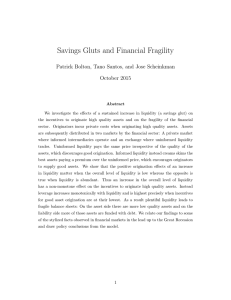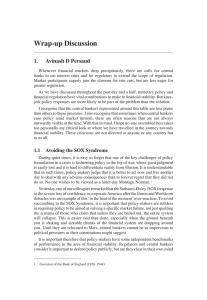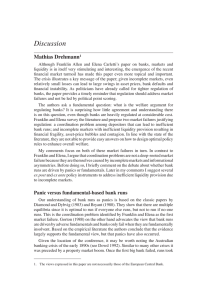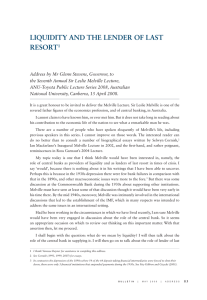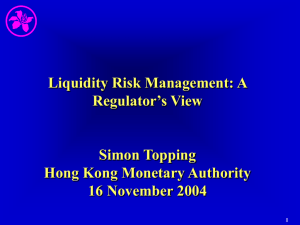Stabilizing Global Financial Markets
advertisement
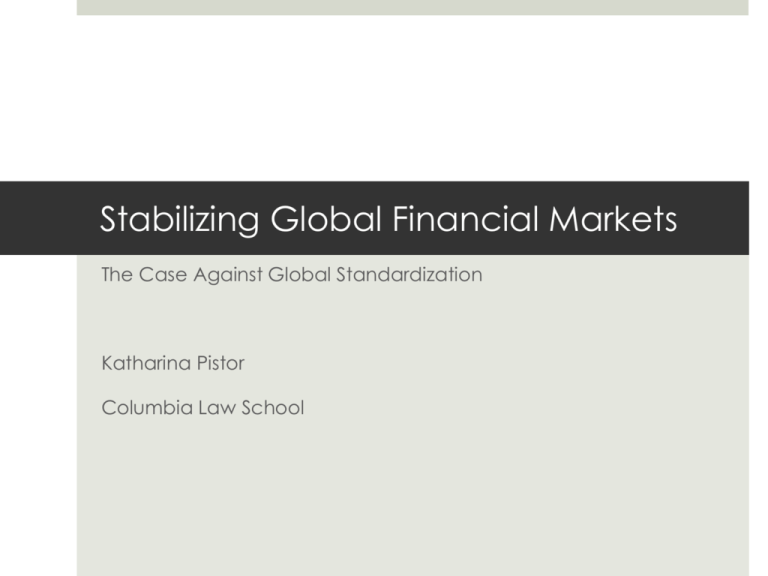
Stabilizing Global Financial Markets The Case Against Global Standardization Katharina Pistor Columbia Law School Outline Points of departure The Structure of Financial Markets Implications for Regulating Global Finance The Case for Flexible Coordination of Regulatory Diversity Points of Departure Yes, incentives matter. However, the root causes of instability are not incentives, but Imperfect Knowledge and Volatility of Liquidity In combination with the profit motive (incentive!), these factors lead endogenously to financial instability Yes, structures matter. Access to liquidity in times of crisis varies; this determines behavior and regulatory preferences Reserve currency Y/N FX reserves Y/N Access swap lines or other forms of cross-border liquidity Y/N The Structure of Financial Markets – Two Views Equilibrium Deviations indicate distorted incentives and/or institutions Institutional fix Disclosure Transaction costs Incentive alignment Regulators can fix it All share same interests Have perfect knowledge how market dynamics will shape incentives in the future Hierarchy Ability to convert claims into cash (liquidity) on demand establishes survival constraint for countries and private actors Determinants Institutions Financial engineering Relation to LLR Gap between expectations and actual outcomes Access to liquidity is uneven Financial Markets Getting a Seat at the Fed’s TAF DZ BK Deutsche Dresdner Mizhuo Standard Chartered Bayerische HV Depfra Bk TokyoMitsub BK of Scotland HSH Nordbank Credit Indus & Comm Sumitomo RBS West LB Dexia Norinchukin Barclays Commerzbank BNP Paribas Arab BKG Corp Bayerische LB Natixis Allied Irish Unicredit Societe Gen. BK of Nova Scot Deutsche BK UBS Toronto Dom Deutsche BK Fortis Royal Bk Ca Funding Liquidity and Debt Shifting in Global Markets Financial Interdependencies and Risk Allocation Banks source in global wholesale markets and shift debt to markets where they maintain lending vehicles (banks and non-banks) to earn higher returns Distribution of Risk is Uneven Across Countries Funding market If collapse of funded (foreign) markets can adversely affect home market (Fed’s TAF) Parent company markets If collapse of target market affects parent banks in home market Target markets Exposure to collapse of global wholesale funding markets without knowledge of local regulators Hierarchy of Global Finance Access to liquidity varies for different actors and countries Current regulatory structures re-enforce structural hierarchy Basel Concordat Home-Host division of regulation and liquidity provisioning Limited liability of parent bank regulators in target markets Source market regulators no responsibility in principle Free capital mobility & strengthening of creditor rights Supports cross-border debt-shifting Crisis management Protection of core, not periphery, of global markets “Where is my swap line?” (Sester) Towards Flexible Coordination of Regulatory Diversity Management of country & actors specific liquidity risk Coordination of countries with weak bargaining power Coordination of policies in source, home country, and target markets Global monitoring of excess liquidity & its sources Global information repository for effective liquidity management strategies Sanctioning mechanisms Designing the Coordinator Credibility/Legitimacy Effective representation of source, home and target markets Convening power Ability to convene regulators, central banks, and private sector representatives Responsiveness Learning by Monitoring Organizational structures to ensure detection of non-routine events Thank you




